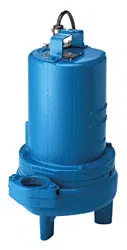Loading ...
Loading ...
Loading ...

9
SECTION E: PREVENTATIVE MAINTENANCE
As the motor is oil fi lled, no lubrication or other maintenance
is required, and generally Barnes Pumps will give very
reliable service and can be expected to operate for years on
normal sewage pumping without failing. However as with any
mechanical piece of equipment a preventive maintenance
program is recommended and suggested to include the
following checks:
1) Inspect motor chamber for oil level and contamination
and repair as required per section F-1.
2) Inspect impeller and body for excessive build-up or
clogging and repair as required per section F-2.
3) Inspect motor and bearings and replace as required
per section F-3.
4) Inspect seal for wear or leakage and repair as required
per section F-4.
SECTION F: SERVICE AND REPAIR
NOTE: All item numbers in ( ) refer to Figures 15 thru 18.
F-1) Lubrication:
Anytime the pump is removed from operation, the cooling oil
in the motor housing (6) should be checked visually for oil
level and contamination.
F-1.1) Checking Oil:
Motor Housing- To check oil, set unit upright. Remove pipe
plug (39) from motor housing (6). With a fl ashlight, visually
inspect the oil in the motor housing (6) to make sure it is
clean and clear, light amber in color and free from suspended
particles. Milky white oil indicates the presence of water. Oil
level should be just above the motor when pump is in vertical
position.
F-1.2) Testing Oil:
1.) Place pump on it’s side, remove pipe plug (39), from
motor housing (6) and drain oil into a clean, dry container.
2.) Check oil for contamination using an oil tester with a
range to 30 Kilovolts breakdown.
3.) If oil is found to be clean and uncontaminated
(measuring above 15 KV. breakdown), refi ll the motor
housing as per section F-1.4.
4.) If oil is found to be dirty or contaminated (or measures
below 15 KV. breakdown), the pump must be
carefully inspected for leaks at the shaft seal (28), cord
assemblies (16) and (56 if used), square ring (27) and
pipe plug (39), before refi lling with oil. To locate the
leak, perform a pressure test as per section F-1.3.
After leak is repaired, dispose of old oil properly, and
refi ll with new oil as per section F-1.4.
F-1.3) Pressure Test:
Pumps that have been disassembled, Motor Housing - If
the pump has been disassembled, the oil should be drained
before a pressure test, as described in section F-1.1. Remove
pipe plug (39) from motor housing (6). Apply pipe sealant to
pressure gauge assembly and tighten into hole (See Figure
2). Pressurize motor housing to 10 P.S.I. Use soap solution
around the sealed areas and inspect joints for “air bubbles”.
If, after fi ve minutes, the pressure is still holding constant,
and no “bubbles” are observed, slowly bleed the pressure
and remove the gauge assembly. Replace oil as described in
section F-1.4. If the pressure does not hold, then the leak must
be located and repaired.
Pumps that have NOT been disassembled, Motor Housing-
The pressure test may be done with the oil at its normal level.
Remove pipe plug (39) from motor housing (6). Apply pipe
sealant to pressure gauge assembly and tighten into hole
(See Figure 2). Pressurize motor housing to 10 P.S.I. Use
soap solution around the sealed areas above the oil level and
inspect joints for “air bubbles”. For sealed areas below the oil
level, leaks will seep oil. If, after fi ve minutes, the pressure
is still holding constant, and no “bubbles”/oil seepage is
observed, slowly bleed the pressure and remove the gauge
assembly. If the pressure does not hold, then the leak must be
located and repaired.
Seal Chamber (DS Units Only)- Set unit on its side with
fi ll plug (44) downward, remove plug (44) and drain all oil
from seal chamber. Apply pipe sealant to pressure gauge
assembly and tighten into hole in outer seal plate (29).
Pressurize seal chamber to 10 P.S.I. and check for leaks as
outlined above.
CAUTION ! Pressure builds up extremely
fast, increase pressure by “tapping” air
nozzle. Too much pressure will damage
seal. DO NOT exceed 10 P.S.I.
F-1.4) Replacing Oil:
Motor Housing- Set unit upright and refi ll with new cooling
oil as per Table 1 (see parts list for amount). Fill to just above
motor as an air space must remain in the top of the motor
housing to compensate for oil expansion (see Fig. 15 or 17).
Apply pipe thread compound to threads of pipe plug (39) then
assemble to motor housing (6).
FIGURE 2
Loading ...
Loading ...
Loading ...
